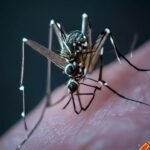Introduction: Crickets are common household pests that can disrupt peaceful evenings with their loud chirping and, in some cases, cause damage to property and crops. While crickets play a vital role in ecosystems as scavengers and food sources for other animals, their presence indoors can be a nuisance. In this comprehensive guide, we’ll explore a variety of strategies and techniques for getting rid of crickets effectively and preventing infestations from recurring.
Understanding Cricket Behavior: Crickets belong to the Gryllidae family and are known for their distinctive chirping sound produced by rubbing their wings together. While many people associate crickets with outdoor environments, some species, such as house crickets (Acheta domesticus) and field crickets (Gryllus spp.), can become pests indoors. Crickets are attracted to warm, humid environments and are often found in basements, crawl spaces, kitchens, and bathrooms.
- Identify Entry Points: The first step in cricket control is to identify and seal entry points where crickets may be gaining access to your home. Inspect the exterior of your home for cracks, gaps, holes, and openings around doors, windows, vents, pipes, and utility lines. Seal any openings with caulk, weatherstripping, or mesh screens to prevent crickets from entering your home.
- Remove Food and Shelter: Crickets are attracted to sources of food and shelter, so eliminating these attractants is essential for controlling infestations. Keep indoor and outdoor areas clean and free of food crumbs, spills, and garbage that may attract crickets. Store food items in airtight containers and clean up pet food and water bowls regularly. Declutter indoor and outdoor spaces to reduce hiding places for crickets.
- Reduce Moisture: Crickets are attracted to moisture, so reducing humidity levels indoors can help deter them from taking up residence in your home. Use dehumidifiers to remove excess moisture from the air, especially in damp areas such as basements, bathrooms, and kitchens. Fix leaky faucets, pipes, and appliances, and ensure proper ventilation in bathrooms and kitchens to prevent moisture buildup.
- Natural Predators: Introducing natural predators such as spiders, lizards, and birds can help control cricket populations outdoors. Encourage natural predators to visit your yard by providing shelter, water, and food sources such as insects and seeds. Consider installing bird feeders or bat houses to attract birds or bats, which are known to feed on crickets and other pests.
- Use Sticky Traps: Sticky traps, also known as glue traps, can be used to capture crickets indoors and outdoors. Place sticky traps in areas where crickets are active, such as along walls, baseboards, and near entry points. Check traps regularly and replace them as needed to maintain effectiveness. Sticky traps can also be used to monitor cricket activity and determine the extent of an infestation.
- Apply Insecticides: Insecticides can be used to control cricket populations indoors and outdoors, particularly in cases of severe infestations. Choose insecticides labeled for use against crickets and follow the manufacturer’s instructions carefully when applying them. Apply insecticides to cracks, crevices, and other hiding places where crickets are likely to harbor. Consider hiring a pest control professional for assistance with insecticide application and control measures.
- Seal Outdoor Trash Bins: Outdoor trash bins can attract crickets and other pests looking for food sources. Keep outdoor trash bins tightly sealed with lids to prevent crickets from accessing them. Clean outdoor trash bins regularly to remove food residue and odors that may attract crickets. Consider using trash bins with tight-fitting lids and locking mechanisms to deter pests.
Conclusion: Controlling cricket populations requires a combination of preventive measures, habitat modifications, and targeted control methods. By identifying entry points, removing food and shelter, reducing moisture, encouraging natural predators, using sticky traps, applying insecticides, and sealing outdoor trash bins, you can effectively eliminate crickets and prevent infestations from recurring. Remember to be persistent and thorough in your efforts to control crickets, as early intervention is key to avoiding larger problems down the road. With proper care and diligence, you can enjoy a cricket-free home and peace of mind knowing that you’ve taken steps to protect your property and family from these pesky pests.




